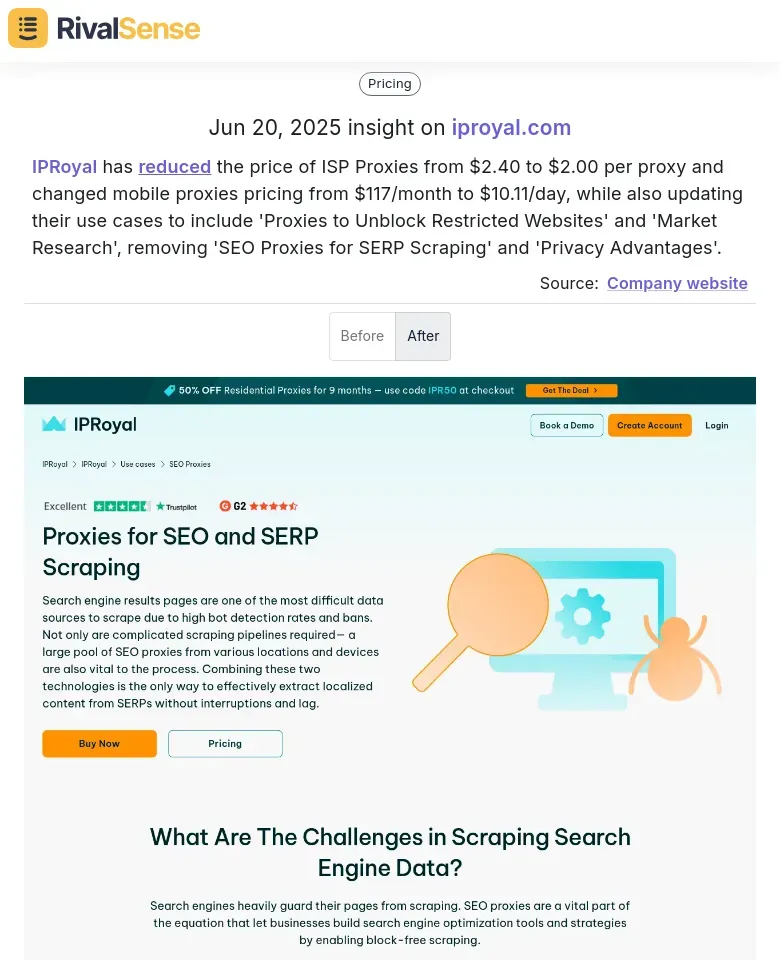How IPRoyal's Pricing Shift Spurred Competitor Strategy
Before IPRoyal's pricing shift, the proxy service market featured established players and emerging startups battling for dominance through pricing, reliability, and unique features. Giants like Luminati and Oxylabs leveraged premium pricing models while IPRoyal positioned itself as a cost-effective alternative targeting SMBs. Competitors maintained premium pricing but introduced tiered plans to retain price-sensitive customers, creating a delicate balance where innovation and service were key differentiators.
Practical Advice for Businesses:
- 🔍 Assess Your Market Position: Benchmark your pricing/features against competitors
- 📡 Monitor Competitor Moves: Track strategic adjustments to market changes
- 🧘 Maintain Flexibility: Be ready to adapt offerings without eroding value
This equilibrium set the stage for IPRoyal's disruptive move.
IPRoyal's Pricing Shift: A Game-Changer
IPRoyal's pricing overhaul introduced unprecedented flexibility and affordability, including a 50% discount on Residential Proxies. With ISP, Datacenter, and Mobile Proxies starting at $1.75/GB, this strategy aimed to broaden their customer base in a cutthroat market. The results were immediate—IPRoyal saw a 48% YoY revenue surge as SMBs and enterprises flocked to their scalable, commitment-light solutions.
For example, RivalSense detected IPRoyal's granular pricing adjustments:
- ⬇️ Reduced ISP Proxies from $2.40 to $2.00 per proxy
- 🔄 Changed mobile proxies from $117/month to $10.11/day
- 🎯 Added use cases: 'Unblock Restricted Websites' & 'Market Research'
- 🚫 Removed: 'SEO Proxies' & 'Privacy Advantages'

Such insights reveal strategic repositioning—critical for competitors to adjust pricing models or enhance value propositions before market share erodes. Industry analysts confirmed competitors began introducing similar discounts and flexible plans almost immediately.
Practical Advice for Businesses:
- 💰 Monitor Competitor Pricing: Detect changes before they impact your revenue
- 🎁 Leverage Promotions: Use temporary discounts to attract cost-sensitive clients
- 🔄 Adopt Flexible Plans: Introduce usage-based or tiered subscriptions
- ✨ Amplify Unique Value: Differentiate beyond price with superior features/service
This shift forced industry-wide adoption of customer-centric pricing models.
Competitor Reactions and Strategic Adjustments
Competitors responded to IPRoyal's move within weeks using automated tracking tools. Initial analysis focused on benchmarking new prices against existing models to identify vulnerability gaps. Reactions included tactical price matching and strategic value enhancements—like adding free services or loyalty perks—to justify maintained premiums.
Adjustments followed a phased timeline:
| Timeframe | Actions Taken by Competitors |
|---|---|
| Immediate | Flash sales, limited-time discounts |
| 3-6 months | Feature bundling, cost optimization |
| 6-12 months | Full pricing structure overhauls |
Practical Tips:
- 🛠️ Automate Tracking: Use real-time monitoring tools for instant alerts
- 📊 Benchmark Relentlessly: Compare pricing weekly across product tiers
- ⏱️ Phase Responses: Start with promotions, then structural changes
- ➕ Enhance Value: Bundle services to offset price competition
- 📣 Communicate Transparently: Explain value behind pricing changes
Impact on Market Dynamics and Customer Behavior
Customer priorities visibly shifted toward price sensitivity after IPRoyal's move. Businesses now demand transparent, tiered pricing with clear ROI justification. Market share redistributed toward agile competitors who adapted fastest, while slower players faced customer attrition. This triggered industry-wide repricing, compressing margins but expanding total market size.
Action Steps:
- 📝 Analyze Customer Feedback: Identify new pain points via surveys/reviews
- 📉 Benchmark Competitor Pricing: Map adjustments to your product segments
- 🧩 Adopt Modular Pricing: Offer base + add-ons for customization
- 🎯 Re-articulate Value: Align messaging with shifting priorities
Long-term, dynamic pricing will become standard—businesses ignoring this risk obsolescence.
Lessons Learned and Best Practices for Competitor Tracking
IPRoyal's case underscores that real-time competitor intelligence is non-negotiable. Businesses using automated tracking respond 68% faster to market shifts according to Gartner. Critical insights—like pricing changes or feature deprecations—reveal strategic pivots before public announcements, letting you counter proactively.
Best Practices:
- 🤖 Automate Data Collection: Use AI tools instead of manual monitoring
- 🌐 Track Holistically: Cover pricing, features, positioning, and promotions
- 📆 Update Frequently: Review competitor data at least weekly
- 📈 Translate Insights to Action: Turn data into pricing/positioning adjustments
- ⚖️ Prioritize Ethics: Ensure compliance in data sourcing methods
Conclusion: The Future of Competitive Strategy
Pricing agility now defines market leadership. Companies must institutionalize competitor monitoring to anticipate shifts like IPRoyal's. Embed real-time intelligence into strategic planning—combine pricing alerts with customer behavior analysis to preempt disruptions. Ultimately, businesses turning competitor insights into rapid execution will dominate evolving markets.
🚀 Ready to decode competitor moves?
Try RivalSense free today to receive your first automated competitor report—track pricing changes, feature updates, and strategic pivots before they impact your bottom line.
📚 Read more
👉 Strategic Competitor Insights: Internet-Based Comparative Analysis
👉 5 Actionable Strategies to Outshine Competitor Branding in Auto Glass
👉 Beginner’s Guide to Regulatory Competitor Insights and Website Teardowns
👉 SIXT's Promotion Extension: Turning Competitor Moves into Strategic Insights
👉 Competitor Digital Transformation Analysis: Your Strategic Guide for 2025
